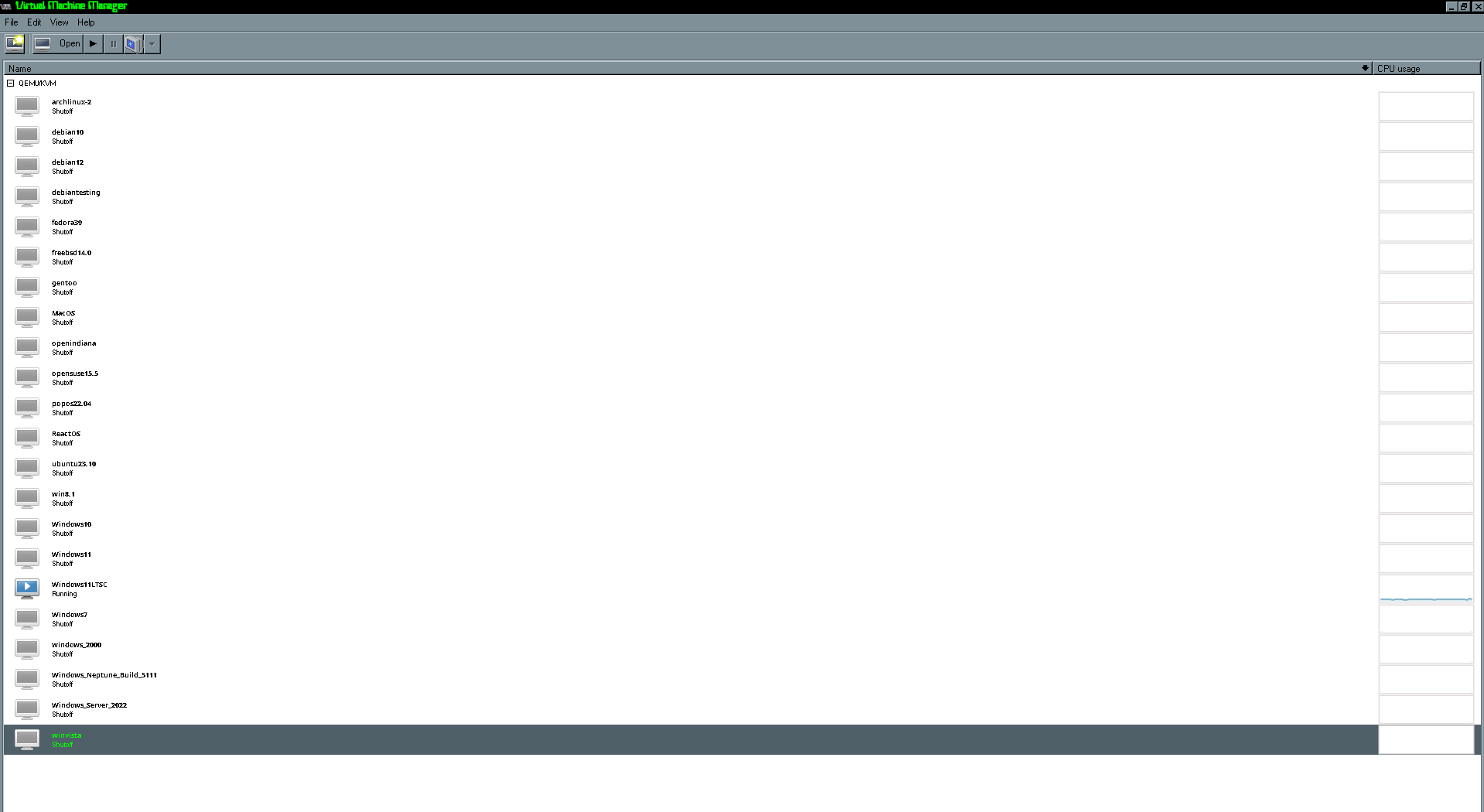Half of these exist because I was bored once.
The Windows 10 and MacOS ones are GPU passthrough enabled and what I occasionally use if I have to use a Windows or Mac application. Windows 7 is also GPU enabled, but is more a nostalgia thing than anything.
I think my PopOS VM was originally installed for fun, but I used it along with my Arch Linux, Debian 12 and Testing (I run Testing on host, but I wanted a fresh environment and was too lazy to spin up a Docker or chroot), Ubuntu 23.10 and Fedora to test various software builds and bugs, as I don’t like touching normal Ubuntu unless I must.
The Windows Server 2022 one is one I recently spun up to mess with Windows Docker Containers (I have to port an app to Windows, and was looking at that for CI). That all become moot when I found out Github’s CI doesn’t support Windows Docker containers despite supporting Windows runners (The organization I’m doing it for uses Github, so I have to use it).
Is this like opening tons of browser tabs?
Well I do but I have a machine with 3/4 of a terabyte of memory on it.
Work scraps are great sometimes.
How are you running the MacOS VMs. The machine I have is a cheese grater so that makes it easier.
I found a prebuilt OpenCore for KVM. https://github.com/thenickdude/KVM-Opencore
I then changed the config.plist to make it think it was a 2019 Mac Pro.
Ok I’ll have to try this. The weird thing is my little test proxmox server is a 2013 trashcan. So this would be like a hackintosh running on Mac hardware. Would that technically be a hackintosh? I’m not really sure. According to the Apple license you can virtualize MacOS if it’s running on Mac hardware. I’m not sure if that requires MacOS as the hypervisor. Regardless this is not something I knew about. Very cool. Thanks for the info.
Are you running macOS or Linux as your host? My MacBook is M1 and I found the performance running ARM windows and ARM Fedora via UTM (qemu) to be pretty good.
On the cheesegrater(2019 MacPro) it’s a little convoluted. During covid times it was my single box lab since it had so much memory (768TB). So I was running nested ESXI hosts and then VMs under that. I also have a M1 MacBook Pro that I had parallels run ARM VMs (mostly MacOS, Windows, and a couple of Debian installs I think).
I have been looking at VMWare alternatives at work so for the hypervisors I’ve been playing around.
I do this stuff for a living but I also do it home for fun and profit. Ok not so much profit. Ok no profit but definitely for the fun. And because I love large electric bills.
That’s a beast of a Mac. Wake on lan is your friend. I have the same problem with my Threadripper. I wrote a script that issues a WOL command to either start/unsuspend my Ubuntu machine so I can turn it off when not in use. It’s probably $70/month difference for me. Most of my virtualization is on Linux but I’ve moved away from VM Ware because QEMU/KVM has worked so well for me. You should check out UTM on the Mac App Store and see if that solves any of your problems.
Man this thread has taught me all sorts of things. I will definitely check out UTM. Thanks for that!!
I did this with Qubes a year ago and haven’t had any issues apart from figuring out the right flags to get the full performance, otherwise the GPU would cap around 30% under load with low CPU load.
Kind of at the mercy of what your motherboard and bios will allow, mine I had to cheese a little and disable the PCI device on boot so I get to decrypt my disk with no screen lol but it works!
Very few people need it but it’s awesome and a lot of fun and lets you spend more time in Linux than dealing with Windows. The VFIO Reddit and Arch wiki are great resources. I have GPU, USB, and Ethernet pass through on my Ubuntu machine and it works great, but I needed the Arch wiki to really figure out what I was doing wrong when I first set it up. Level1Techs is also a good resource on YouTube and forums because they are big into VFIO and SR-IOV. Next time you get a PC, make sure to look for more PCI lanes and bifurcation support on your motherboard. Gen 4 is a great option because it generally has enough lanes and the ram and ssd are much cheaper than Gen 5. GPU choice doesnt matter much but if you’ve got AMD watch out for the reset bug. Basically you can start a VM but once you quit it the cards state is unavailable for further use (eg a second VM session or reopening your DE if you’re using a single GPU setup) unless you restart your host. There are some workarounds but personally I’d avoid it if possible. Onboard graphics (iris or amd APU) are recommended. Older hardware can get cheap so good luck saving up if this is something you want to do!
It’s only insane if you have them all running at once.
Have you automated creation?
I have about that many. Looks good to me! I have two Windows VMs. One for work and presentations. One for games and Adobe. A bunch of random Linux VMs trying to get a FireWire card to work and a Windows 7 VM for the same reason. I’ve also for several Linux VMs trying out new versions of Fedora, Ubuntu, or Debian. A couple servers. Almost none of them are ever turned on because my real virtualized workloads run in docker or LXC! I never could get Mac VM to work but I have an AMD CPU and a MacBook so not too high priority.
Screen sharing from Linux is amusing though, so far I’ve yet to have anyone even mention it (hyprland so looks very different to Windows
With that many Windows (gasp) ones, no… I’m afraid you are not
I had a VM but somehow the virtual drive got corrupted? And it wouldn’t let me install, update or uninstall VC++ runtime as a result. I’m gonna try again later, but it’s a worrying start.
That just sounds like classic Winsanity right there, not a hard drive issue.
I’ve had another try, this time I set chattr +C on the image directory just in case my using btrfs was causing issues.
not even sure distro tube has this many lmao
Why would anybody need an OS other than the bottom one?
I think the answer is obvious. There are so many better alternatives available today. Some examples include:
- Windows ME
- Glorious Leader’s Red Star OS
- Temple OS
- Don’t use an operating system - sacrifice all your your time to studying the ways of the mighty Zarthadonatoxator instead. All hail Zarthadonatoxator! Zarthadonatoxator is the only true way!
For windows I either use a mingw toolchain from mxe.cc or just run the msvc compiler in wine, works great for standard C and C++ at least, even when you use Qt or other third party libraries.
Interesting enough, there is a project that I’ve found that runs Windows in a Docker container as a VM.
https://github.com/dockur/windows
I run a Windows 10 LTSC that way to run things like Blue Iris for my security cameras, and some stuff to track my solar installation.
Sounds nice, how useable is it?
runs Blue Iris and I can rdp into it over a cellular modem fine. And its running on an ancient i3
Yes but most of them are off lol
If I could get vbox to work* on my laptop or find the drive to learn QEMU, then I would have plenty on there. For now I’m just stuck with plenty on my desktop running win10.
*I have installed it a few times on my Debian based distro, but I swear every time I do nothing to it and it destroys itself. Works fine one day, then the next I turn on my laptop, after the only changes being that I created and ran a VM and it decided to hate me and not even boot the program. I think I’m just cursed.
What about Virt Manager GUI, which is what I use here? It’s a frontend for QEMU and it’s not that difficult, honestly.
I’ll have to look into it because I’d love to have some VMs on my laptop since it way outperforms my desktop specs wise
*sane
*some
*lame












